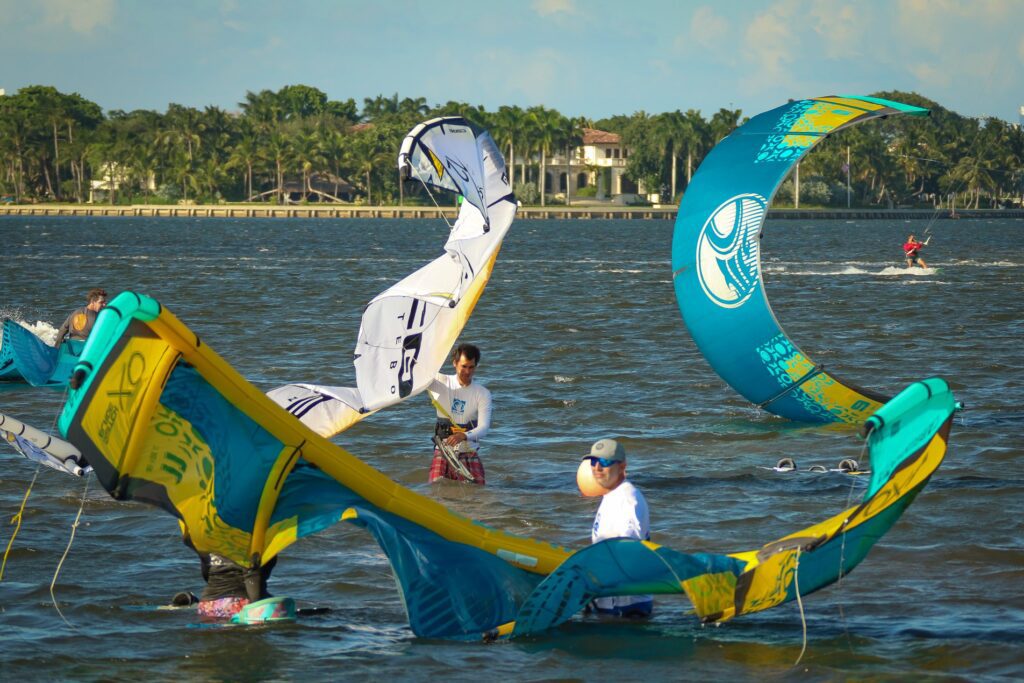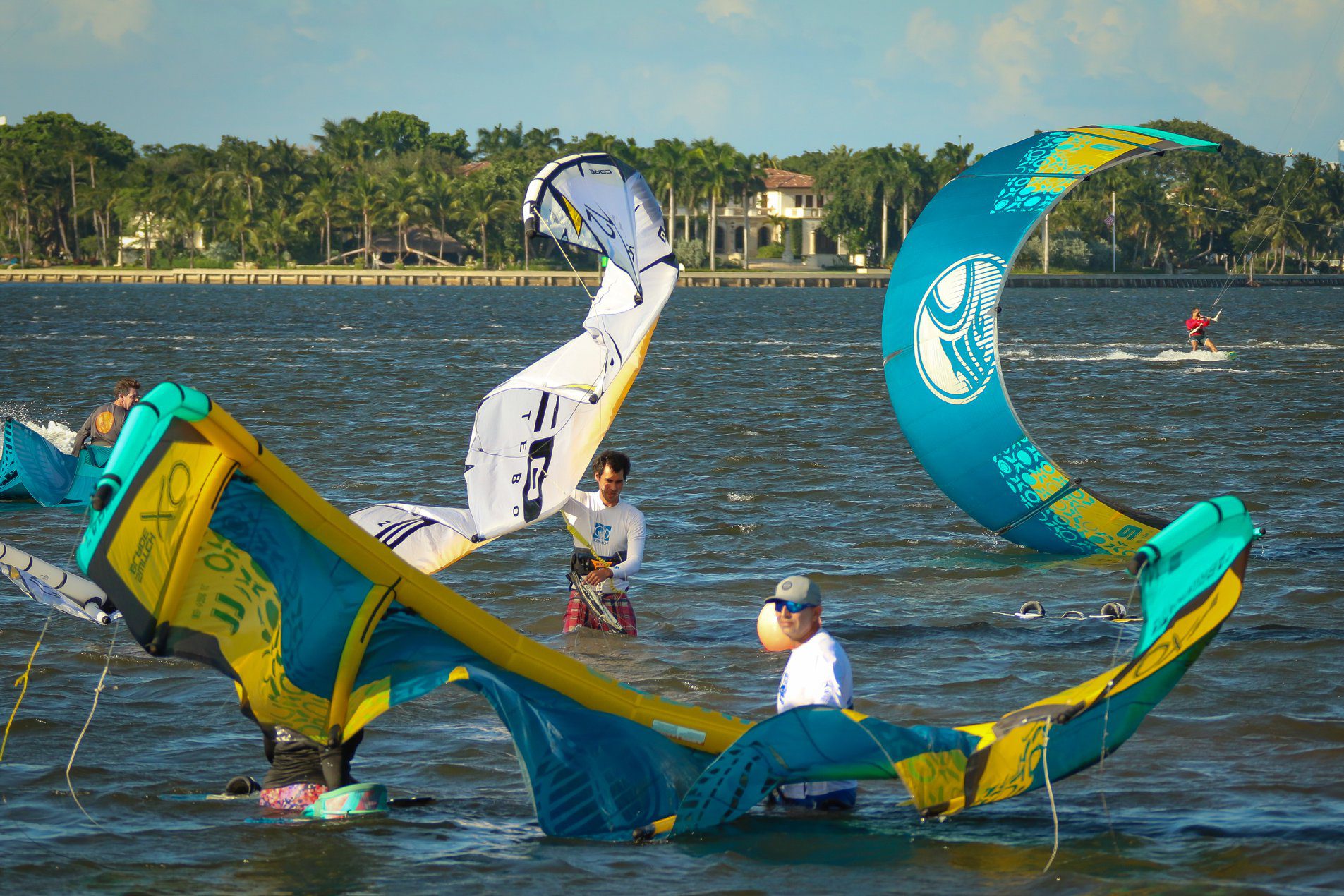
Different Types of Kiteboarding Kites.
Kiteboarding is an exciting and thrilling sport that has recently gained popularity. It requires a kite, which comes in various shapes and sizes, to generate lift and power.
Overview of Different Types of Kiteboarding Kites.
Each type of kite has its unique purpose and can be used to perform different tricks and maneuvers. This article will explore the different types of kiteboarding kites and their purposes. We will discuss the advantages and disadvantages of each type of kite and the best kite for beginners. Finally, we will provide some tips on how to choose the right kite for your needs. Whether a beginner or an experienced kiteboarder, this article will help you find the perfect kite for your next adventure.
Kiteboarding is an exciting sport that has grown in popularity over the years. It involves using a kite to power a board across the water. Kiteboarding is a great way to enjoy the outdoors and have a thrilling adventure. To get the most out of your kiteboarding experience, choosing the right kite for your skill level and riding style is essential. Several different types of kites are available, each with unique characteristics and advantages.
The most common type of kite used for kiteboarding is the inflatable kite. These kites are made of lightweight fabric and are inflated with air. They are typically larger than other types of kites and provide much power. Inflatable kites are easy to launch and land on, and they are also very durable. They are great for beginners, as they are relatively easy to control and can be used in various wind conditions.
Foil kites are another popular type of kite used for kiteboarding. Foil kites are made of a lightweight fabric and are designed to generate lift when the wind passes over them. Foil kites are more efficient than inflatable kites and are great for experienced riders who want more power out of their kite. They are also more maneuverable than inflatable kites, making them great for performing tricks.
Hybrid kites are a combination of inflatable and foil kites. They are designed to provide the best of both worlds, combining an inflatable kite’s power with a foil kite’s maneuverability. Hybrid kites are great for intermediate riders who want to get the most out of their kiteboarding experience.
The last type of kite used for kiteboarding is the parafoil kite. Parafoil kites are made of a lightweight fabric and are designed to provide lift when the wind passes over them. They are more efficient than inflatable kites and great for experienced riders who want more power out of their kite. Parafoil kites are also more maneuverable than inflatable kites, making them great for performing tricks.
No matter what type of kite you choose, choosing one that is right for your skill level and riding style is essential. With the right kite, you can have a unique kiteboarding experience and make the most of your time on the water.
Understanding the Benefits of Kiteboarding Kites.
Kiteboarding is an exciting and thrilling sport that has become increasingly popular recently. It combines the thrill of surfing, the power of wind, and the agility of a kite to create an adrenaline-filled experience. Kiteboarding is an activity that can be enjoyed by people of all ages and skill levels, and it offers a variety of benefits.
Kiteboarding is a great way to stay active and get exercise. The physical activity involved in kiteboarding helps to strengthen muscles, improve balance, and increase cardiovascular health. It also helps to build core strength and flexibility, which can help improve overall health and fitness. Additionally, kiteboarding can help to reduce stress and improve mental clarity.
Kiteboarding is also a great way to explore the outdoors. Kiteboarders can explore new areas and experience different types of terrain. Kiteboarding can take you to places you would never have gone otherwise, and it can help you appreciate the beauty of nature.
Kiteboarding is also a great way to meet new people and make friends. Kiteboarding is a social sport and a great way to meet people who share your interests. You can also learn from experienced kiteboarders and make connections with other kiteboarders.
Kiteboarding is also a great way to challenge yourself and push your limits. Kiteboarding can help you learn new skills and become more confident. It can also help you become more comfortable taking risks and reaching new heights.
Kiteboarding is a great way to have fun and enjoy the outdoors. It’s a great way to spend time with friends and family, and it’s a great way to get away from the hustle and bustle of everyday life. Kiteboarding can help you relax and enjoy the beauty of nature.
Kiteboarding is a great way to experience the wind’s power and the open water’s freedom. It’s a great way to explore the world and experience the thrill of adventure. Kiteboarding is an activity that can be enjoyed by people of all ages and skill levels, and it offers a variety of benefits.
Exploring the Different Sizes of Kiteboarding Kites.
Kiteboarding is an exciting and popular sport that has grown in popularity. As with any sport, the equipment is essential, and kiteboarding is no exception.
One of the essential pieces of equipment for kiteboarding is the kite itself. Kites come in a variety of sizes and shapes, and each size has its advantages and disadvantages.
Kite size is determined by the size of the kite’s canopy, which is measured in square meters. The larger the top, the larger the kite. Beginners typically use smaller kites, while more experienced riders use more giant kites. The size of the kite is also determined by the rider’s weight and wind conditions.
Smaller kites are generally more maneuverable and easier to control, making them ideal for beginners. They are also less powerful and can be used in lighter winds. However, they are less potent than more giant kites and can be challenging to keep in the air in stronger winds.
More giant kites are more powerful and can generate more lift, allowing riders to stay in the air longer and reach higher speeds. They are also more stable and easier to control in strong winds. However, they are more challenging to maneuver and can be difficult to launch in lighter winds.
Kite size is an essential factor when choosing a kite for kiteboarding. Smaller kites are great for beginners, while giant kites are better suited for more experienced riders. Choosing the right size kite for your skill level and the wind conditions you will be riding in is necessary.
Comparing the Materials Used in Kiteboarding Kites.
Kiteboarding is an exciting and popular sport that has seen a surge in popularity in recent years. Kiteboarding involves using a kite to propel the rider across the water. The kite is the essential piece of equipment for kiteboarding, and the materials used to construct it significantly impact the kite’s performance.
Kiteboarding kites are typically made from either polyester or nylon fabrics. Polyester is a synthetic material that is lightweight and strong, making it an ideal choice for kiteboarding kites. Polyester is also resistant to UV rays, which helps to protect the kite from fading or tearing in the sun. Nylon is another synthetic material that is often used in kiteboarding kites. Nylon is slightly heavier than polyester but is also solid and resistant to UV rays.
In addition to the fabric used to construct the kite, the kite also contains several other materials. The kite’s leading edge is typically made from a durable plastic material, such as Dacron or Kevlar. The kite’s struts are usually made from a lightweight and strong material such as carbon fiber or fiberglass. The kite’s bridle is generally made from a strong, lightweight material such as Dyneema or Spectra.
When comparing the materials used in kiteboarding kites, it is essential to consider their performance. Polyester and nylon fabrics are lightweight and strong, making them ideal for kiteboarding kites. The kite’s leading edge is typically made from a durable plastic material, such as Dacron or Kevlar. The kite’s struts are usually made from a lightweight and strong material such as carbon fiber or fiberglass. The kite’s bridle is generally made from a strong, lightweight material such as Dyneema or Spectra.
Overall, the materials used in kiteboarding kites can significantly impact the kite’s performance. Polyester and nylon fabrics are lightweight and strong, making them ideal for kiteboarding kites. The kite’s leading edge is typically made from a durable plastic material, such as Dacron or Kevlar. The kite’s struts are usually made from a lightweight and strong material such as carbon fiber or fiberglass. The kite’s bridle is generally made from a strong, lightweight material such as Dyneema or Spectra. By considering the kite’s performance, riders can make an informed decision when selecting the materials for their kiteboarding kite.
Investigating the Different Wind Ranges of Kiteboarding Kites.
Kiteboarding is an exciting and thrilling sport that involves riding a kiteboard across the water while being pulled by a kite. Kiteboarding requires the use of a kite, which is an inflatable, sail-like device that is attached to the rider’s harness and powered by the wind. The power of the current determines the speed and direction of the kiteboarder, and it is essential to choose the right kite for the conditions.
Kiteboarding kites come in various sizes and shapes, and each kite is designed to perform best in different wind ranges. Wind range is the range of wind speeds in which a kite can be used; it is essential to choose the right kite for the conditions. Kites are typically divided into low, mid-range, and high winds.
Low-wind kites are designed to perform best in light winds of 8-15 knots. These kites are usually giant and have more surface area to catch the wind. They are also typically more stable and easier to control. Low-wind kites are ideal for beginners, providing more control and stability in light winds.
Mid-range kites are designed to perform best in moderate winds of 15-25 knots. These kites are usually smaller and have less surface area to catch the wind. They are also typically more maneuverable and responsive. Mid-range kites are ideal for intermediate and advanced riders, providing more speed and maneuverability in moderate winds.
High-wind kites are designed to perform best in strong winds of 25 knots and above. These kites are usually the smallest and have a little surface area to catch the wind. They are also typically the most responsive and maneuverable. High-wind kites are ideal for experienced riders, providing the most speed and maneuverability in solid currents.
When choosing a kite for kiteboarding, it is essential to consider the kite’s wind range. Different kites are designed to perform best in different wind ranges, and choosing the right kite for the conditions is essential. With the right kite, kiteboarders can enjoy a thrilling and exciting ride in any wind condition.
Kiteboarding is an exciting and thrilling sport that people of all ages and skill levels can enjoy. You can experience the thrill of flying high in the sky with the right kite and conditions. Various kiteboarding kites are available, each designed for different purposes. Kites can be used for freeriding, freestyle, racing, and big air. With the right kite and the proper technique, you can experience the thrill of kiteboarding. Whether you are a beginner or an experienced kiteboarder, there is a kite that will suit your needs. With the right kite and conditions, you can enjoy the exhilarating sport of kiteboarding.
Excerpt.
Kiteboarding is an exciting sport that requires the use of a kite. Many different types of kites are available, each with its own purpose. Some are designed for speed, others for power, and still others for maneuverability. Understanding the different types of kites and their uses is essential for any kiteboarder.
Author
Latest entries
 WatersportsMay 10, 2023Qatar GKA Freestyle Kite World Cup, Fuwairit Kite Beach, Qatar: 31 January – 04 February – 2023
WatersportsMay 10, 2023Qatar GKA Freestyle Kite World Cup, Fuwairit Kite Beach, Qatar: 31 January – 04 February – 2023 WatersportsMarch 30, 2023Seven Navigation Tips That All Kite Surfers Should Know.
WatersportsMarch 30, 2023Seven Navigation Tips That All Kite Surfers Should Know. WatersportsMarch 30, 2023Why Safety First is the Most Important Aspect of Kitesurfing.
WatersportsMarch 30, 2023Why Safety First is the Most Important Aspect of Kitesurfing. WatersportsMarch 30, 2023Tips to Improve Your Body Drag Skills in Kitesurfing.
WatersportsMarch 30, 2023Tips to Improve Your Body Drag Skills in Kitesurfing.




